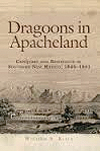
Dragoons in Apacheland: Conquest and Resistance in Southern New Mexico, 1846–1861, by William S. Kiser, University of Oklahoma Press, Norman, 2013, $29.95
Although the New Mexican territorial capital of Santa Fe surrendered to Brig. Gen. Stephen Watts Kearny’s Army of the West without firing a shot in August 1846, his promise to afford permanent protection to inhabitants proved empty. To defend the newly conquered territory from Apache raids, the Army stationed there the 1st and 2nd Dragoon regiments, while in that same year Congress created the Regiment of Mounted Rifles (RMR), which received the “pay of infantry and forage of dragoons.” Most infantry soldiers serving in New Mexico belonged to the 3rd Infantry Regiment, a unit unsuited to fighting the elusive Apaches.
William Kiser earlier wrote Turmoil on the Rio Grande: The Territorial History of the Mesilla Valley, 1846–1865. In his new book he examines the role U.S. soldiers played in New Mexico up to 1861 and the reasons the federal government failed during that period either in forcing the Apaches to coexist with the white settlers or in countering their depredations. One problem lay in the fact that many of the soldiers were Irish or German immigrants, while most of the locals spoke only Spanish. Officers and soldiers alike developed racially superior attitudes against the populace they were supposed to protect. Delays in pay, casualties and difficult desert conditions made matters worse. In 1852 a frustrated Colonel Edwin V. Sumner wrote to Washington, recommending the abandonment of New Mexico Territory to the Indians and the “idle and worthless” Mexicans, and that the removal of the Army would be in the government’s best economic interests.
Fortunately for New Mexico’s future as a state, not all officers shared his opinion. Major Enoch Steen, for example, understood how rich the territory was in minerals. But another perplexing problem arose from the discord of the Office of Indian Affairs, which in 1849 was transferred from the War Department to the Department of the Interior. In 1852 the commissioner of Indian Affairs issued a proclamation to allow Indian agents to accompany military expeditions in order to stop the Army from attacking peaceful Indian bands. Colonel Sumner, for one, absolutely refused to comply.
The power struggle after New Mexico became a territory was continuous between Apaches, who were protecting their homeland and believed the environment was something holy, and the invading soldiers, settlers and miners (gold at Pinos Altos, copper at Santa Rita). There was no way of reaching a peaceable agreement. According to Kiser, government officials, merchants and soldiers acted in the advancement of imperialist ideologies intended to hasten the economic exploitation of the landscape and to exert social power and authority over cultures they deemed inferior. Dragoons in Apacheland reveals the mistakes soldiers made in their dealings with the Indians and how the process of Americanizing New Mexico and Arizona would take some time.
Thomas Zacharis




